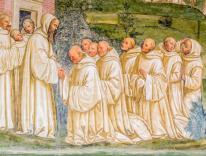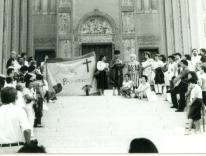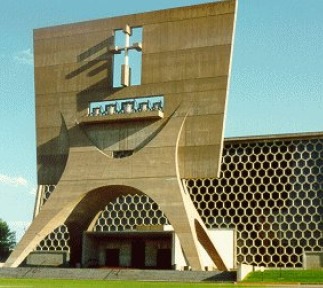 Marcel Breuer would have been proud. So would Baldwin Dworschak. And maybe even St. Benedict as well. Breuer, the New York Bauhaus-trained architect, and Dworschak, the far-sighted abbot of a Benedictine monastery in rural Minnesota, were the central figures in a unique collaboration that produced one of the masterpieces of twentieth-century religious architecture, the acclaimed St. John’s Abbey and University Church. Thanks to Dworschak’s extraordinary vision and quiet leadership, St. John’s forged a partnership with the Hungarian-born Breuer that produced what the architect I. M. Pei said would be a world-famous building if it were located in New York City instead of the northwoods of Minnesota.
Marcel Breuer would have been proud. So would Baldwin Dworschak. And maybe even St. Benedict as well. Breuer, the New York Bauhaus-trained architect, and Dworschak, the far-sighted abbot of a Benedictine monastery in rural Minnesota, were the central figures in a unique collaboration that produced one of the masterpieces of twentieth-century religious architecture, the acclaimed St. John’s Abbey and University Church. Thanks to Dworschak’s extraordinary vision and quiet leadership, St. John’s forged a partnership with the Hungarian-born Breuer that produced what the architect I. M. Pei said would be a world-famous building if it were located in New York City instead of the northwoods of Minnesota.
Breuer died in 1981 and Dworschak fifteen years later, but both were there in spirit last October when St. John’s celebrated the fiftieth anniversary of the dedication of the starkly modern church, which art historian Whitney Stoddard hailed as “the most exciting architectural story since the building of the great medieval churches of Europe.”
The saga of how a monastic community following the fifteen-hundred-year-old Rule of St. Benedict and devoted to a life of “worship and work” chose an avant-garde Jewish architect best known for his furniture designs and private residences to build its central place of worship began in January 1951, just after the forty-four-year-old Dworschak was elected the sixth abbot of St. John’s.
Founded in 1856 by five monks from St. Vincent’s Abbey in Latrobe, Pennsylvania, St. John’s was intended to serve German immigrants and Chippewa Indians. It grew haphazardly. Its centerpiece was built after the Civil War, a red brick quadrangle that housed the monks and their college and preparatory school. The quadrangle was anchored by a traditional Romanesque church with soaring ninety-nine-foot twin towers. Completed in 1882, they became a symbol of St. John’s.
One of the first problems confronting the new abbot, a soft-spoken English professor who reluctantly took office after the three-decade reign of his strong-willed predecessor, was how to care for the growing number of aged and infirm members of the monastic community. At the time, St. John’s was the largest Benedictine abbey in the world with more than 330 members. Today it is the second largest in the Western Hemisphere with more than 150 professed monks.
“It all started because we had to take care of the older retired monks,” Dworschak told me in 1991, long after his retirement in 1971 at the age of sixty-five. (I graduated from St. John’s University in 1958, just as construction of the church got underway, and was interviewing him for the St. John’s alumni magazine.) He said he was inclined at first to carry on as his predecessor had done, “because many of the older monks felt you shouldn’t make a sudden change after thirty years. But the demands of the community by 1951 were beginning to show the need for expansion.”
Guided by St. Benedict’s admonition that abbots should seek the counsel of their community on important decisions, Dworschak appointed a six-member planning committee to advise him on what should be done to provide for the older monks and meet the demands of a rapidly expanding postwar student enrollment at the abbey’s university and preparatory school. Two years later, the committee submitted its recommendations. It called for construction of a number of facilities, including quarters for the older monks, a new monastery wing and a new church that would reflect in its architectural form the movement led by Fr. Virgil Michel, the St. John’s monk who charted the course for liturgical renewal among U.S. Catholics that found its ultimate expression in the Second Vatican Council.
Dworschak took the unusual step of inviting twelve internationally renowned architects to design a comprehensive building plan for the second centenary of St. John’s. He made it clear the church was to be the cornerstone of the plan, declaring it should be “truly an architectural monument in the service of God.” He added, “The Benedictine tradition at its best challenges us to think boldly and to cast our ideals in forms which will be valid for centuries to come, shaping them with all the genius of present-day materials and techniques.”
And in words that must have seemed presumptuous to the architects, he wrote, “We feel the modern architect with his orientation toward functionalism and honest use of materials is uniquely qualified to produce a Catholic work. In our position, it would...be deplorable to build anything less, particularly since our age and our country have thus far produced so little truly significant religious architecture.”
The audacity of his action is evident in the architects he approached. Seven were from the United States and five from Europe. All were famous or about to become famous. They included Walter Gropius, onetime dean of the Harvard School of Design, and Breuer, his protégé and former partner in private practice, as well as Finnish-American architect Eero Saarinen, Pietro Belluschi of the Massachusetts Institute of Technology, and Thomas Sharp of Oxford, England.
To Dworschak’s surprise, all responded positively, and all but Saarinen and Belluschi, who had other commitments, applied for the assignment. Five of them—Breuer, Gropius, Richard Neutra of Los Angeles, Barry Byrne of Chicago and Robert Murphy of St. Louis—were invited to St. John’s for interviews.
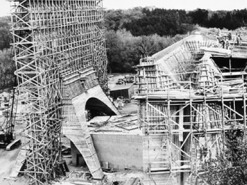 Dworschak asked his confreres to rank the five architects. After intensive study and debate, they selected Breuer—who had helped define modernism in America after fleeing Nazi Germany in the 1930s and had just received his first major commission, the UNESCO headquarters in Paris. “He struck us as being not only an outstanding architect, but a simple, straightforward, sincere, and rather humble person,” Dworschak explained.
Dworschak asked his confreres to rank the five architects. After intensive study and debate, they selected Breuer—who had helped define modernism in America after fleeing Nazi Germany in the 1930s and had just received his first major commission, the UNESCO headquarters in Paris. “He struck us as being not only an outstanding architect, but a simple, straightforward, sincere, and rather humble person,” Dworschak explained.
Breuer’s response set the tone for a close relationship between his firm and St. John’s that continues today. “What I see before me,” he wrote to Dworschak, “is a community of men deliberately oriented towards God, guided at all times by a ‘Rule’ of life which sets it down as a necessary condition to live a life of ‘worship and work’.... I can see that for you a sense of life, its ultimate meaning, translates readily into a sense of place that looks far beyond what is here.”
But Breuer quickly discovered his new client was unlike any other he’d ever had, as Dworschak recalled in a 1990 memoir. “When we invited Marcel Breuer to design buildings for us, we asked him to serve our community by pulling the community well beyond its practical intentions so as to serve its most profound needs, namely, to give, architecturally, a true and lasting expression of the life that it represents. The buildings we created together were a new thing, expressing not just the style of the architect, but also the spirit of the community.”
In early 1954, after much discussion and sometimes blunt criticism by the monks of Breuer’s preliminary designs, he came to St. John’s with assistant Hamilton Smith and unveiled a comprehensive hundred-year plan that would replace 75 percent of the existing buildings. It called for construction of nineteen new buildings grouped around a central quadrangle, beginning with a monastic wing and a monumental church, and including a library, science hall, and dormitories, to serve the monastic, student, and parish community.
Breuer’s plan drew international attention and acclaim. The editor of Liturgical Arts magazine called it “a milestone in the evolution of the architecture of the Catholic Church in this country.” Robert Murphy, one of the architects who lost out to Breuer, was a gracious loser. Noting the scenic setting of the monastic wing and church, which overlooked a pine-fringed lake on a 2,400-acre campus, he declared, “I believe [the] design is a very striking solution of the problem, beautifully situated and most expressive.”
Time magazine predicted that the cost of the plan could exceed $8 million, far beyond St. John’s financial means, and speculated that it would take many years to complete. “But Abbot Baldwin [Dworschak] and his black-cowled brothers are in no mad rush,” the magazine reported at the time. “‘After all,’ he said last week, ‘what are a few generations to the Benedictines?’”
The initial phase of Breuer’s plan, a box-like rectangular monastic wing, was completed in 1956. Work on the church began two years later and was scheduled to take three years, which coincided with a period of historic change in the Catholic Church. As Dworschak noted, “The period 1958 to 1961...was a time when change was about to spring upon the church in that most radical form, the Second Vatican Council, which would institute fundamental changes in the life of the church, especially for the laity’s more active participation in the liturgy.”
But some in the American Catholic hierarchy wondered if Rome would allow Breuer’s radical design. Dworschak said Bishop William Brady of Sioux Falls, South Dakota, warned him “very emphatically...you will not get by with the building of that church you are planning.” Although Brady would be proved wrong, there was good reason for his prediction. “Up to the opening of the Council, the whole church had been held on a tight rein,” Dworschak wrote in his memoir. “The building of a church and its architectural style were instinctively felt to be governed by ecclesiastical authority.”
Uncertain whom he should submit Breuer’s design to at the Vatican, Dworschak sent Fr. Cloud Meinberg, a trained architect who was his principal liaison with Breuer, to Rome in 1956. His instructions: “to make inquiries of anyone who seemed to have the authority to approve modern art and architecture for church use.”
Meinberg was directed to Cardinal Costantini, the apostolic chancellor, who “showed considerable interest and surprise, but in no way expressed disapproval, and added that if asked for his approval, he would have a favorable opinion.” With that assurance, Breuer moved ahead to carry out his design, which anticipated many of the changes later ordered by Vatican II, including altars that allowed priests to face the congregation.
Still, the church that would bring St. John’s international acclaim almost never got built because of concerns about its cost. In November 1957, after being told it would exceed $2 million, the monastic chapter voted not to proceed with construction. But five months later, after intense negotiations between Dworschak and Breuer resulted in design changes that lowered the construction cost by $100,000, and after a fundraising drive that brought in more than $300,000, the chapter approved Breuer’s plan by a vote of 103 to 17. Ground was broken on May 19.
With monks supplying some of the unskilled labor in the early stages of construction, the abbey church was completed in August 1961. The result was a radical and, to many people, even shocking departure from traditional church architecture, especially that of the Gothic churches in the predominantly German Catholic communities surrounding St. John’s.
Its most dramatic feature was a 112-foot trapezoidal banner of reinforced concrete holding the five bells that had tolled the hours in the twin towers of the old church since 1882. Inspired by churches he had seen on Greek islands, Breuer placed the bells and a large oak cross in two openings in the banner. Because the main entrance of the church faced north, the rear surface of the banner was designed to reflect sunlight into the church through a stained glass wall—an important feature in Minnesota’s cruel winter months.
The church itself was a huge trapezoidal building, also of reinforced concrete, with corrugated lateral sides covered by granite. It seated two thousand people in the nave and on a cantilevered balcony, and it had an underground crypt with several altars. Its most dramatic feature, aside from the bell tower, was a three-storey honeycombed wall of stained glass, comprising 486 brilliantly colored hexagonal windows.
At the main entrance, directly under the banner, was an atrium with a baptismal font and modernist statue of John the Baptist. Under a three-ton wood baldachin was a dramatic altar of white granite, surrounded by choir stalls for the monks, with the abbot’s throne at the rear. The floor was made of polished red bricks—more than eight thousand of them—and the bare interior walls were of exposed concrete.
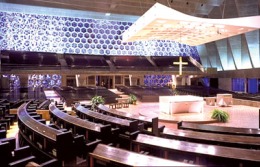 Some critics, including monks and parishioners, found the church uninviting, austere, and not conducive to devotion. But it was judged an architectural masterpiece by others. Bernard Jacob, a fellow of the American Institute of Architects, called it “an important and meaningful example of religious architecture in this century.” Declaring that the church represented a “rare symbiosis between architect and client that produces extraordinary results,” Jacobs concluded in 1981 that the building “is unlike anything Breuer had designed before and probably better than anything he designed thereafter.”
Some critics, including monks and parishioners, found the church uninviting, austere, and not conducive to devotion. But it was judged an architectural masterpiece by others. Bernard Jacob, a fellow of the American Institute of Architects, called it “an important and meaningful example of religious architecture in this century.” Declaring that the church represented a “rare symbiosis between architect and client that produces extraordinary results,” Jacobs concluded in 1981 that the building “is unlike anything Breuer had designed before and probably better than anything he designed thereafter.”
Breuer himself seemed to agree with at least part of Jacob’s judgment. After watching the four-hour rite of consecration and dedication from the front row of the balcony, he told Dworschak, “All I can say, Father Abbot, is that this is the first building I have designed and the first object I have designed which has been made so sacred, or, as you would say, consecrated to God. I am more deeply moved by this than I can tell you.”
When Breuer died in 1981, Dworschak, who had retired ten years earlier, paid tribute to him at a memorial Mass in the great church that resulted from their collaboration. “We thank God for him,” he declared. “If a community has with great care selected a competent and skilled person as architect for its church, it will receive from him a design which will stimulate and inspire as well as serve the needs of the community for a space or a building for praying, singing, for listening and speaking, for active participation—where the mysteries of God are recalled and celebrated in human history.” Declaring that Breuer “knew that he would have to be faithful both to what we asked of him and, at the same time, to his own instincts and talents,” Dworschak added, “the kind of fidelity with which Breuer responded to our deeper spiritual needs...was possible only because of a profound relationship which came to exist between Breuer as architect and the monastic community.”
There is an ironic footnote to the story of the relationship between Breuer and the St. John’s monks. Though eight Breuer-designed buildings, including the church, a new monastery wing, a library, a science center, and four student residences, would be built between 1954 and 1968, St. John’s abandoned the rest of his ambitious plan, partly because of financial constraints and partly because the local architects brought in to complete the plan did not want to follow it.
Dworschak, always the gentleman, would not criticize his successor or his community’s decision, but he clearly felt they had not honored the covenant he made with Breuer. “I don’t like to say this lest I give the wrong impression,” he told me in 1991, “but at some point, the community decided to kind of forget Breuer’s plan and proceed independently.... I think we should have insisted that the plan was not done lightly.”
And how did Dworschak think Breuer would react if he knew that his hundred-year plan had been abandoned? “I think he was realistic,” the abbot said. “I think he knew that in time his plan would not be followed closely. I don’t know whether I or anybody else should have tried to say to the younger monks, ‘Look, this is a sacrosanct plan, you can’t touch it or interfere with it.’ The [new] architect...said he respected Breuer and would not depart from his style, but he found that very hard to do. He did change the plan, and we have what we have now.”
Perhaps the best commentary on the Breuer church is that of Fr. Hilary Thimmesh, the youngest of twelve monks Dworschak appointed in 1956 to plan the church. Thimmesh, who later became president of St. John’s University, wrote in a memoir of how he felt the day the church was dedicated: “I remember how beautiful the church was in the stillness of the evening after the crowd had gone and Marcel Breuer’s lighting made the concrete and steel of the banner seem weightless and the granite clefts of the side walls already timeless under the night sky.”
Please email comments to [email protected] and join the conversation on our Facebook page.
Previous Story
Beyond Austerity
Next Story
Standing Fast
